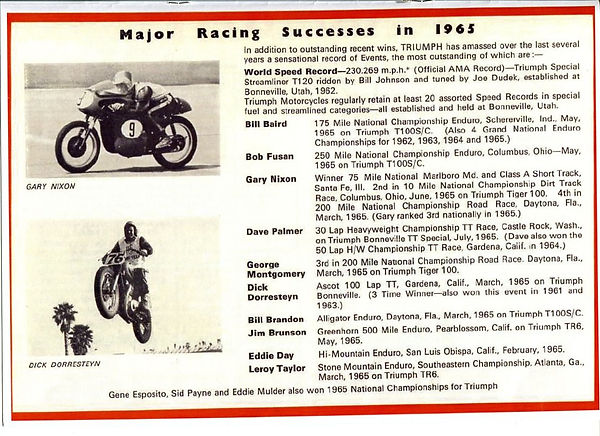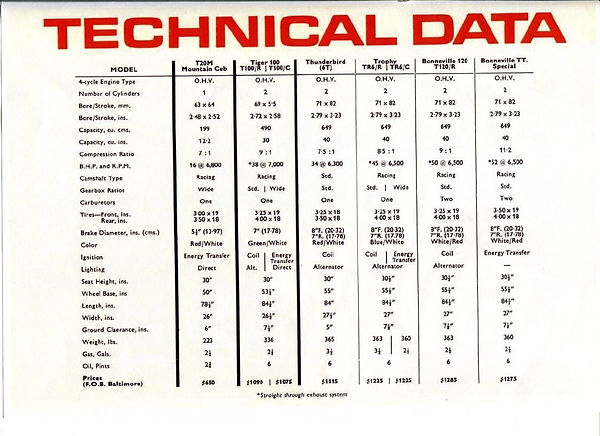1966 TriCor Brochure
A second 1966 brochure from TriCor, minus the colour photography and using images of the bikes that were in all probability supplied by the factory, tidied up with various cables etc. airbrushed out. Consequently, these images are not reliable as sources to determine the specification of East Coast models.
This publication is however of more use to those interested the history of the bikes than the full version as it provides specifications and technical data. Power output for the TT Special is given as 52 b.h.p. at 6,500 r.p.m. as opposed to 50 for the T120R. Compression ratio is given as "11.2" (not "11.2:1"). Personally, I feel the entire "11.2:1" issue arose from a misprint in the 1964 US Replacement Parts Catalogue which indicated that the T120C TT had "Piston 11.2 C.R.", part number "CP201". This refers to a "Carton Pack".
The US Replacement Parts Catalogues were supplements to the main Replacement Parts Catalogue containing different parts as fitted to the US models only. Referencing Replacement Parts Catalogue No. 2 (from engine number DU5825) for the 1964 "B" Range models gives the contents of CP201: piston rings, gudgeon pin and "E5317 Piston C.R. 11:1 (Alcohol fuel)". "11.2" or even "11.2:1" never appears in the Replacement Parts Catalogues as the compression ratio for the pistons used in the TT Special: from 1964 they were always given as 11:1. It seems likely that the entire "11.2" compression ratio issue arose from the error in the 1964 US Replacement Parts Catalogue and was replicated in various brochures. It has now found its way into books and magazines as well, becoming an accepted "truth" - there are plenty of TT Special "experts" out there ready to "correct" those who state that TT Specials had 11:1 pistons. I'm unaware of Triumph ever giving compression ratios figures of greater accuracy than a half - they're only meant as a rough guide I'd suggest - and it seems illogical that they would suddenly use a fifth.
One interesting point which is never mentioned in the Replacement Parts Catalogues, or the factory production records, but is contained in JoMo Service Bulletin No. 3-66 "1966 'B' and 'C' Range Mid-Year Modifications": from engine number DU31119 all T120TTs were fitted with a "Racing exhaust cam (E3134 pattern)". This is the first time I've seen anything to suggest the TT Specials ever had different cams fitted to those on the T120R or TR6R roadsters.
In his "Bonneville & TR6 Motorcycle Restoration Guide (essential reading for anyone interested in the US Triumphs), David Gaylin makes the point, "The 1966 model year was a major one of changes and upgrades for the Bonneville and Trophy 650, many being introduced during the course of the season". Later he states that "The TT Specials incorporated all T120R improvements announced for 1966, including new high performance camshafts (#E4819 - intake, E4885 - exhaust). At engine number DU31119, the exhaust cam was changed again (#E5047)".
Replacement Parts Catalogue No.4, from engine number DU24875 for the 1966 model year gives the E4819/E4885 cam combination for all T120s (including the TT). Replacement Parts Catalogue No. 5, from engine number DU44394, for the 1967 model year, gives inlet cam as E4819, exhaust E5047. E4819 is an E3134 racing profile cam, as is E5047, while E4855 has a "Sports" profile. Engine number DU31119 is the first of a batch of TT Specials built in December 1965 (this seems to be when the "T120TT" engine prefix was introduced, replacing the old "T120C" prefix used on the TT Specials and (until the end of the 1965 model year), the very rare East Coast-only Bonneville scramblers. JoMo were correct when they said that the "Racing exhaust cam" was introduced for the "T120TT". However, it seems evident that it was also introduced across the entire Bonneville and Trophy 650 range, and was not limited only to the TT Special. The TT Special may have once had a "hotter" cam than the roadsters - but it was only for a very limited period part way through the 1966 model year!


Factory images - not reliable as an indicator of Eastern spec bikes - shouldn't be interpreted as meaning that 1966 East Coast TT Specials all left the factory with alloy 'guards and two-tone seats, for example (though some might have).





